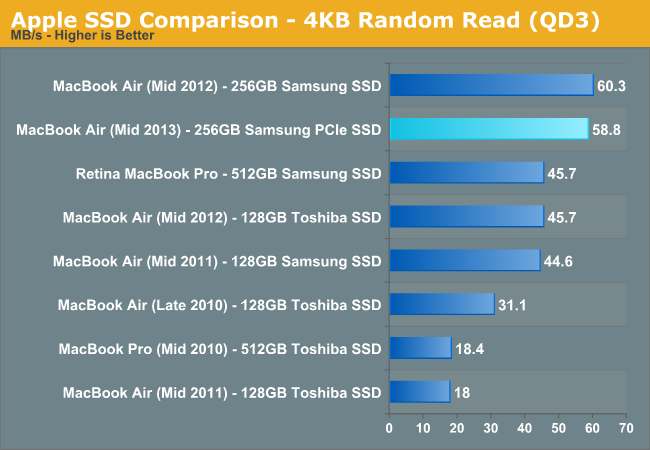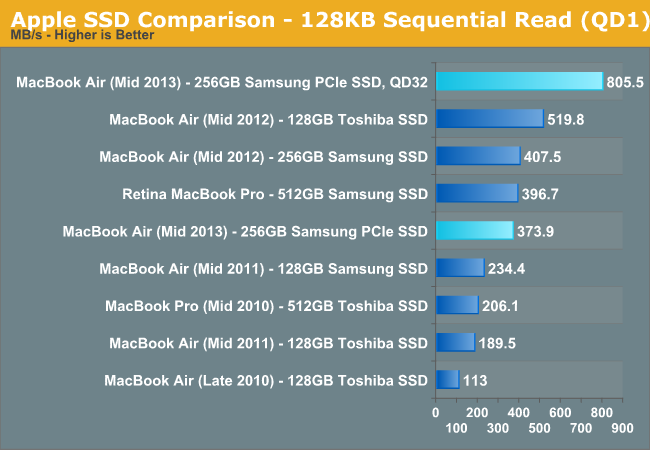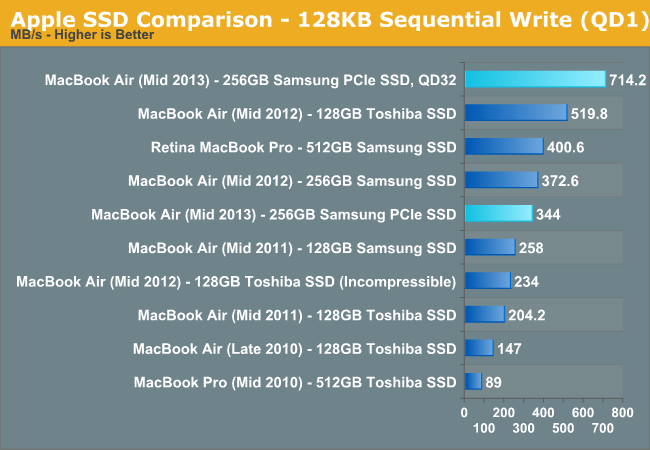The 2013 MacBook Air Review (13-inch)
by Anand Lal Shimpi on June 24, 2013 12:01 AM ESTPCIe SSD Performance
I created a Boot Camp partition of around 120GB and ran our client iometer benchmarks to put the new PCIe SSD’s performance in perspective.
Peak random read performance is roughly comparable to the previous-generation Samsung controller. Random write performance took a bit of a hit but it's still more than fast enough for client workloads. Sequential speeds are much improved but the gains are really only visible at high queue depths. Low queue depth sequential transfers can’t be split up enough in order to really require PCIe.




What does this mean in the real world? The new SSD is definitely snappier in system use. Wake from sleep is a bit quicker, as are application launches. The funny thing is that with the exception of high-speed Thunderbolt arrays, most external sources aren’t fast enough to even stress the new storage subsystem in the MacBook Air. Large file copies confined to the drive itself benefit a bit as well. I saw roughly 300MB/s reads and 300MB/s writes when copying a large dmg from/to the MacBook Air’s PCIe SSD (compared to roughly 200/200MBps on the old Samsung SATA SSD from the rMBP15).
If you have an external Thunderbolt array with at least a couple of drives, you should have no issues matching the MBA’s internal SSD performance.
Seeing as how this is our first experience with Samsung’s PCIe SSD controller, I wanted to get a feel for how the drive behaved under extended high queue depth random writes. I ran a modified version of our IO consistency test. The test was modified to run in a 91GB space on the MBA’s Boot Camp partition. I made sure to fill the rest of the drive completely, but the random writes were effectively constrained to 91GB of LBAs. When I get back from the UK I’m going to try setting up an external boot drive and will do some more extensive testing on the drive.
The IO consistency results, at least within a somewhat constrained space actually look really good. I have a feeling that Samsung might have improved its IO consistency story with this generation, but I’ll wait on saying for sure until I’ve had a chance to do some more work with the controller. For the vast majority of users however, solid random write performance like this over a 91GB space on a full drive is actually very good news.













233 Comments
View All Comments
airmantharp - Monday, June 24, 2013 - link
I'd prove that LG makes a better screen than Samsung- but it's already been proven.Malih - Monday, June 24, 2013 - link
The laptop focuses on being lightweight, thus thin, thus limited battery capacity,and limited battery capacity doesn't play well with high res display,
They could choose to increase resolution with haswell and keep the same battery life, but seeing as they chose battery shows where they are focusing with Air.
That means if you want high res display, then get Retina MBP instead.
airmantharp - Monday, June 24, 2013 - link
Your iPhone would like to have a talk with you.seapeople - Tuesday, June 25, 2013 - link
And tell you about what? It's similar display resolution?abazigal - Monday, June 24, 2013 - link
You can always pay more to have the air ship with more ram.darwinosx - Monday, June 24, 2013 - link
Or faster procs or more sad.Strulf - Monday, June 24, 2013 - link
Yep, 8 GB are possible. In the generation before already.MatthiasP - Monday, June 24, 2013 - link
The resolution is quite OK if you consider the battery life and weight you get. Also both displays still offer a higher DPI than what you can get on the best desktop displays. What is really disappointing is the lack of an IPS panel. There is no excuse for that on a mobile device.Exelius - Monday, June 24, 2013 - link
8gb is available as a BTO option. I have a 11" 2012 MBP with an i7-3667U and 8gb RAM and it's more than enough for running a VM and even for doing some database work. Honestly, the machine is still mostly bound by the speed of the SSD for every workload I use it for. I love the size of the 11".The only complaint I have is that the GPU is a bit anemic, which the Haswell update seems to have addressed. I find that the 2012 Air has some noticeable jerkiness driving a 1080p display in OS X, which I suspect is a large part of the reason that the Airs haven't had a larger display. Hopefully, with that limitation removed, Apple can start to put some higher resolution displays in these machines over the next year or two.
darwinosx - Monday, June 24, 2013 - link
Read the article you are commenting on. 1400 X 900.You can get this laptop with 8 GB of you want.
1600 X 900 is to high for a 13 inch for most people. Tiny icons and text. Thats why Apple goes all the way to retina display on their higher end laptops instead of some half measure that won't satisfy anyone.
Dell makes junk and fails to support it. People looking at Mac's aren't going to consider a Dell with Microsoft's latest mediocrity of an OS.
This is of course a premium product in build quality, quality control, service and support, custom components like the ssd and battery. Not some plastic Dell with the cheapest possible parts they could get out of China this week.
Despite that retail starts at $1099 and they can be found cheaper online. Show me a PC laptop even close to this price, build, customizations and certainly service and support. How about a PC laptop with a working trackpad...
If you want a higher res screen and 8 GB out of the box thats the 13" retina. A new version of it is coming shortly and will be thinner and lighter than the current model.